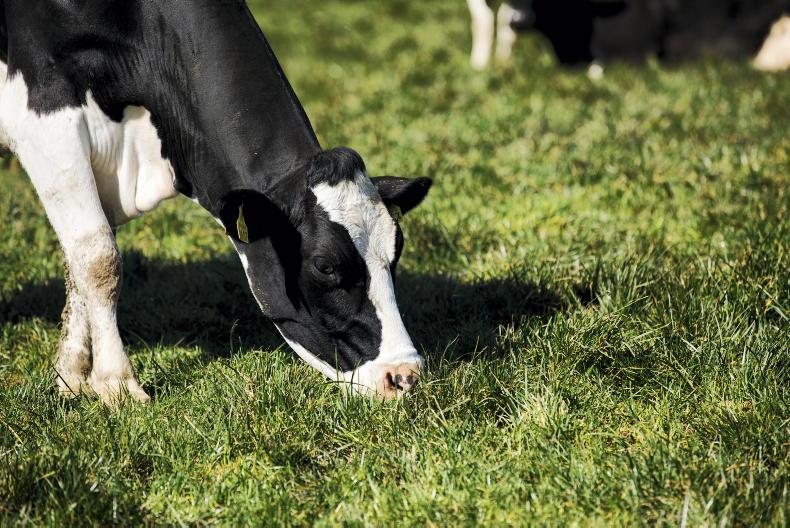It has been a challenging start to the 2021 grazing season for most participants on the Dairylink Ireland programme.
Cold temperatures have hampered grass growth and high levels of rainfall, particularly at the end of last week, affected ground conditions.
But better weather has arrived and forecasts of warmer temperatures with limited rainfall are being given for the coming days.
Here are some tips Dairylink adviser Aidan Cushnahan is giving programme participants to help them get the grazing season back on track.
1 Walk the grazing block
Grass supplies and ground conditions will change very quickly and programme farmers could soon find themselves with surplus grass that needs baling. It is therefore essential that the grazing block is walked at least once a week, but ideally twice a week at this time of year.
“What you perceive is happening and what is actually happening on the ground may not be the same. If conditions are wet, ask yourself is it possible to get cows out for a few hours during the day. Grazing for three or four hours can account for around 40% of a cow’s daily DM intake,” Aidan said.
2 Assess grass supplies
Dairylink participants have been set up with grass measuring equipment and grass budgeting software. Programme farmers are currently aiming to have cover per cow at around 160-180 kgDM.
So, on a grazing block stocked at four cows per hectare, average available cover should be less than 720 kgDM/ha. In Northern Ireland, where average farm cover is usually given in terms of total cover, this equates to a cover of 2,220 kgDM/ha (ie 720 plus 1,500).
3 Advice if not measuring
In reality, most commercial dairy farmers are not measuring grass covers or using budgeting software. However, Aidan’s advice to these farmers is still to walk your grazing block regularly and assess covers.
“The simplest measure is to compare sward heights to the length of your hand. If grass is as tall as the distance from the tip of your middle finger to your wrist, then it is ideal for grazing,” he said. How many paddocks are above this height right now? If you have more than a week’s grazing at this height already, then you are carrying a surplus and should mow at least two or three days’ grazing for baled silage.
4 Irregular grass wedge
Ideally, you want grass covers at different heights across the grazing block. A key benefit of measuring and setting up a grass wedge is that it allows you to compare grass supply to demand across all paddocks.
If you simply measure grass and work off the 180kgDM/cow figure, then you might have the correct average cover but there could too many paddocks with a similar cover. This means you could be facing a deficit in the short term and a surplus in a few weeks.
With re-growths poor in recent weeks and grass covers currently low in many paddocks, this could be a common problem on many farms and will require regular monitoring.
5 Avoid building too much grass
With grass supplies tight for much of the spring, there could be a temptation to hold off with baling excess grass when a surplus eventually develops.
However, Aidan advises Dairylink farmers to bale off surplus grass as soon as conditions allow. The sooner a paddock is baled, the sooner it’s growing again and back in the grazing rotation.
If you delay taking out surplus grass, then cows could end up grazing heavy covers of lower-quality grass. Or, if surplus grass is baled too late, then it will put more pressure on the rest of the grazing ground and a grass deficit could soon develop.
6 Spreading fertiliser
Dairylink farmers are being encouraged to spread 30 units of nitrogen per acre if fertiliser has not be applied to grazing ground within the past four weeks. This will allow nitrogen to be available to the grass plant as soon as temperatures rise and growth rates take off.
On farms where fertiliser has been spread more recently, but grass has not responded, then cold temperatures could be the limiting factor. It could be worth monitoring growth carefully over the coming days and if things have not improved by next week, then spread fertiliser again.
7 Adjust feed settings
The inclement weather has meant feed settings have been below seasonal targets for most of the grazing season so far. These should be reviewed as soon as cows are able to produce more milk from grass.
Under ideal conditions, the target for this time of year is to produce maintenance (M) plus 20 litres from grass. As the weekly table below indicates, all Dairylink participants are still below this at present.
“Under difficult grazing conditions, feed extra concentrate and have feed settings at M+15 for cows and M+12 for first lactation heifers. But remember to change this back when conditions improve,” Aidan said.
8 Topping and pre-mowing
Grass is now shooting so an important focus on Dairylink farms is achieving good clean-outs in paddocks to maintain sward quality in the next grazing round.
The aim is to clean swards down to around 4cm and if target residuals are not hit, paddocks should be topped after cows. Some programme farmers pre-mow grass in front of cows which can allow higher intakes (if allocations are right) and a clean residual cover.






 This is a subscriber-only article
This is a subscriber-only article












SHARING OPTIONS: